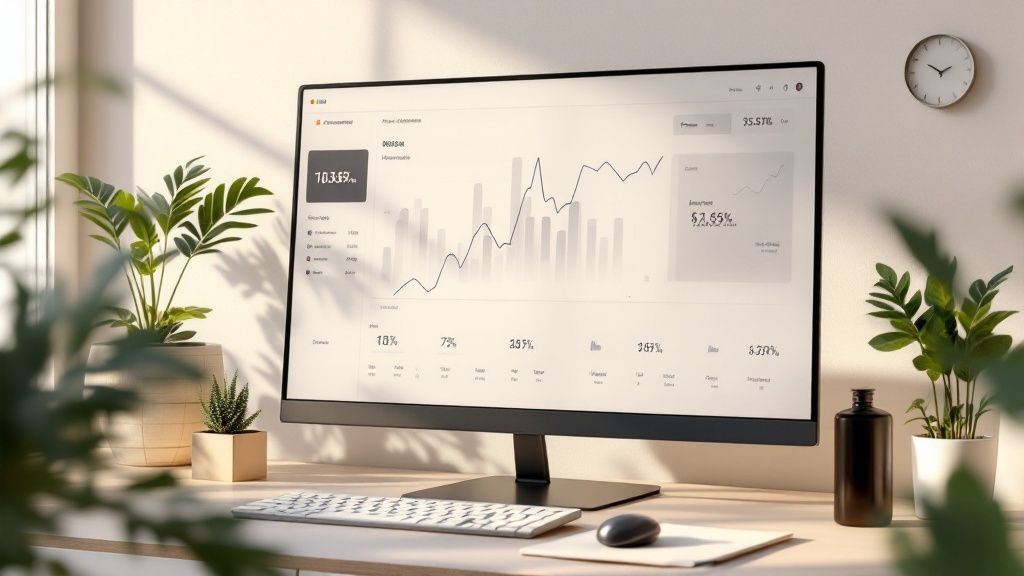E-commerce conversion optimization: 10 proven tips
April 23, 2025

Understanding Your Conversion Benchmark Reality

Let's be honest: many e-commerce store owners are unsure about the effectiveness of their conversion rates. Is their store performing well, or is it lagging behind? This uncertainty often comes from comparing their performance against broad, and often misleading, averages. Understanding what a "good" conversion rate looks like for your business is the key to effective e-commerce conversion optimization.
Why Average Conversion Rates Can Be Misleading
The often-cited "average" e-commerce conversion rate can be a deceptive metric. A global average doesn't account for critical factors like your specific industry, your business model (B2B vs. B2C), or even seasonal shopping trends. Relying solely on this average can lead to inaccurate performance assessments and misdirected optimization efforts.
Think of it like comparing your local basketball team’s performance to the NBA average. It’s not a realistic comparison.
Averages also hide the significant performance gap between top performers and those struggling. In 2025, e-commerce conversion rate benchmarks are predicted to show a significant disparity. Top-performing brands are expected to achieve rates of 4.8% or higher, dominating the top 20% of digital storefronts. Meanwhile, those with rates below 0.2% will likely struggle in the bottom quintile.
The current global average hovers around 3.18%, but this varies widely across industries. For instance, B2B e-commerce typically lags at 1.8% due to complex, high-value purchase cycles often involving multiple decision-makers. LittleData's research reveals that surpassing the 3.2% threshold places businesses in an elite performance tier, though optimization beyond this point sees diminishing returns for many retailers. For more insights into conversion rates, explore these Ecommerce Conversion Rate Optimization Statistics.
Establishing Realistic Benchmarks
Instead of fixating on a potentially misleading average, concentrate on establishing realistic benchmarks tailored to your specific circumstances. This involves a three-pronged approach:
-
Industry Analysis: Research the typical conversion rates within your e-commerce niche. Are you selling high-ticket items or everyday essentials? This greatly impacts customer behavior and purchase decisions.
-
Competitor Benchmarking: Analyze the performance of your direct competitors. What are their conversion rates? What strategies do they employ? Competitor analysis offers valuable insights into what’s effective in your target market.
-
Internal Historical Data: Track your own conversion rate trends over time. This reveals seasonal fluctuations, the impact of your past optimization efforts, and highlights potential areas for improvement.
This data-driven approach allows you to set attainable targets and effectively measure your progress. It's about understanding your specific position and identifying realistic steps for improvement. For further guidance on optimizing your e-commerce conversions, check out this article on How to master e-commerce conversion optimization.
Contextual Factors Influencing Conversion Rates
Numerous factors influence conversion rates. Here are a few key considerations:
-
Brand Recognition: Well-established brands often see higher conversion rates thanks to built-in customer trust.
-
Website User Experience (UX): A smooth and intuitive website experience is crucial for improved conversions.
-
Pricing Strategy: Competitive pricing and well-placed discounts significantly influence purchasing decisions.
-
Marketing and Advertising: Effective marketing drives qualified traffic to your store, leading to higher conversion potential.
Understanding these influencing factors provides a more nuanced perspective on your conversion benchmark reality and allows you to prioritize optimization strategies effectively. This moves you beyond chasing arbitrary numbers and focuses on building a truly high-converting online store.
To better understand typical conversion rate ranges across different industries, take a look at the table below:
E-Commerce Conversion Rate Benchmarks by Industry
| Industry | Average Conversion Rate | Top 20% Threshold | Bottom 20% Threshold |
|---|---|---|---|
| Fashion | 2.0% | 4.0% | 0.5% |
| Electronics | 1.5% | 3.5% | 0.3% |
| Food & Beverage | 2.5% | 5.5% | 0.8% |
| Beauty | 3.0% | 6.0% | 1.0% |
| Home & Garden | 2.2% | 4.5% | 0.6% |
This table showcases illustrative benchmark ranges. Actual benchmarks can vary based on specific niches and market conditions.
As the table demonstrates, conversion rates can differ significantly across industries. The top performers in each sector consistently outperform the average, highlighting the potential for growth through targeted optimization strategies. Understanding these industry-specific benchmarks provides a more realistic context for evaluating your own performance.
Finding Your Store's Unique Conversion Killers

Every e-commerce store faces challenges, especially those struggling with low conversion rates. Hidden obstacles often turn potential customers away. These "conversion killers" can be hard to spot without the right tools and strategies. Instead of guessing, smart merchants use behavior tracking to pinpoint where and why visitors abandon their purchases. This data-driven approach is key to effective e-commerce conversion optimization.
Unmasking Hidden Patterns With Behavior Tracking
Think of your online store as a physical marketplace. You see customers enter, browse, and some make purchases. But what about those who leave empty-handed? Behavior tracking tools like those offered by Hotjar provide the insights you need to understand these lost opportunities. By tracking actions, you can identify patterns and fix underlying issues affecting your conversion rate.
-
Heat Mapping: Heatmaps visually represent visitor activity on your pages, showing clicks, scrolls, and mouse hovers. This highlights areas of interest and potential friction points. For example, low clicks on a call-to-action button may suggest poor placement or unappealing design.
-
Session Recordings: These recordings offer a "movie" of individual visitor sessions, revealing how they interact with your store. This uncovers unexpected navigation issues or form difficulties. A session recording might reveal customers struggling to find a product's size chart.
-
Exit-Intent Analysis: This technology detects when visitors are about to leave. You can trigger a targeted message or offer, like a discount or free shipping. This is a powerful way to recapture abandoning visitors and convert them into customers.
From Symptoms to Root Causes
Behavior tracking is more than just data collection. It's about separating surface-level symptoms from the underlying root causes of conversion challenges. For example, a high cart abandonment rate is a symptom. The root cause could be high shipping costs, a complex checkout, or limited payment options.
This distinction is crucial for focusing your e-commerce conversion optimization efforts. Addressing root causes creates significant, sustainable improvements compared to patching surface problems. Research shows many brands' conversion rates are below projected averages. Learn more about these important conversion rate optimization statistics.
Turning Data Into Actionable Insights
Combining these behavior tracking methods gathers valuable data to shape your e-commerce conversion optimization strategy. This lets you take direct action to improve your results.
-
Identify friction points: Find where visitors encounter obstacles and abandon purchases.
-
Optimize user experience: Improve website navigation and flow to encourage conversions.
-
Personalize the customer journey: Tailor offers and messaging to individual behaviors.
-
Test and refine strategies: Use A/B testing to validate changes based on tracked behavior.
Data-driven e-commerce conversion optimization replaces guesswork with strategic action. By understanding the "why" behind visitor behavior, you target the unique conversion killers affecting your store. This leads to sustainable growth and allows you to implement strategies that address the core challenges hindering your success.
Crafting Product Pages That Actually Convert
Product pages are the core of e-commerce. They're where potential customers decide to make a purchase. However, many product pages fall short of effectively influencing buying decisions. Let's explore how to create product pages that truly drive conversions.
The Power of Persuasion: Emotional and Rational Drivers
Effective product pages cater to both the emotional and rational aspects of a customer's decision-making process. Emotions ignite interest, while logic validates the purchase.
-
Emotional Appeal: High-quality images and compelling storytelling create desire and establish a personal connection with the customer. Imagine a product page for a luxury car, showcasing lifestyle imagery that evokes a sense of freedom and adventure.
-
Rational Justification: Detailed specifications, transparent pricing, and accessible shipping information provide the practical details needed to justify the purchase. This addresses any potential concerns a customer might have.
This blend of emotional engagement and rational reassurance forms the basis of a high-converting product page.
Guiding the Customer Journey: Structuring Information Hierarchies
A cluttered, disorganized product page can be just as frustrating as a messy store. A clear information hierarchy is crucial.
-
Above-the-Fold Essentials: The most important information, including the product title, main image, and price, should be placed "above the fold"—the portion of the page visible without scrolling. This ensures immediate visibility.
-
Strategic Content Placement: Organize product details, customer reviews, and shipping information in a logical sequence. This guides the visitor towards a purchase without overwhelming them.
-
Clear Call to Action: A prominent and persuasive call to action, such as "Add to Cart" or "Buy Now," should be readily available.
By structuring your product pages effectively, you create a seamless user experience that encourages conversions.
Leveraging Social Proof: Building Trust and Credibility
Social proof is invaluable for e-commerce. It’s similar to seeking recommendations before trying a new restaurant.
-
Customer Reviews and Testimonials: Feature positive reviews prominently. These authentic endorsements build trust and credibility.
-
Trust Badges and Security Seals: Displaying trust badges from reputable organizations like the Better Business Bureau reassures customers about their purchase security.
-
Social Media Integration: Integrate social media feeds to showcase user-generated content related to your products, providing real-world examples of their use and enjoyment.
By leveraging social proof, you foster a sense of community and trust, encouraging conversions.
Optimizing for Mobile: The Conversion Battleground
With the prevalence of mobile shopping, mobile optimization is no longer optional—it's essential.
-
Responsive Design: Ensure your product pages adapt seamlessly to various screen sizes and orientations, providing a consistent user experience.
-
Page Load Speed: Optimize images and code to ensure fast loading times. Slow loading speeds can lead to page abandonment. Tools like Google PageSpeed Insights can help analyze and improve your website’s performance.
-
Touch-Friendly Navigation: Implement touch-friendly elements, such as large buttons and easily scrollable content, to enhance the mobile shopping experience.
Prioritizing mobile optimization allows you to capture a larger market share and maximize your conversion potential.
Creating Urgency (Without Being Pushy): Encouraging Immediate Action
Creating a sense of urgency can motivate purchases, but it should be done strategically.
-
Limited-Time Offers: Promote time-limited discounts or special bundles to encourage immediate action. Offering free shipping for a limited time can be a strong incentive.
-
Low Stock Indicators: Display low stock warnings for popular items to create scarcity and encourage quick purchases.
-
Time-Sensitive Messaging: Use phrases like "Don't miss out" or "Limited quantities available" to subtly create urgency.
By using these strategies thoughtfully, you can motivate conversions without resorting to aggressive tactics. This contributes to positive customer experiences and fosters loyalty.
To further understand the impact of different product page elements on conversion, let's examine the following table:
Product Page Elements Impact on Conversion
Data showing how different product page elements impact conversion rates, based on A/B testing results
| Page Element | Average Conversion Impact | Implementation Difficulty | Best Practices |
|---|---|---|---|
| High-Quality Images | +20% | Medium | Use professional photography, showcase product in use |
| Detailed Product Descriptions | +15% | Low | Include key features and benefits, address customer concerns |
| Customer Reviews | +10% | Low | Display prominently, encourage reviews from verified buyers |
| Clear Call to Action | +5% | Low | Use strong verbs, make button visually prominent |
| Mobile Optimization | +10% | Medium | Responsive design, fast loading speed, touch-friendly navigation |
| Limited-Time Offers | +15% | Medium | Clearly communicate offer details, set a deadline |
| Low Stock Indicators | +5% | Low | Display for genuinely low stock items, avoid manipulative tactics |
As the table illustrates, elements like high-quality images and limited-time offers have a significant impact on conversion rates. While some elements, like mobile optimization, require more effort to implement, the potential return justifies the investment. A well-crafted product page is a vital investment in your e-commerce success.
Transforming Cart Abandonment Into Completed Sales
Abandoned carts present a significant challenge for e-commerce businesses. Industry averages indicate that over 70% of online shopping carts are abandoned before purchase. This represents a substantial, often untapped, opportunity for increasing sales. This section explores key strategies to transform abandoned carts into completed purchases by optimizing the checkout process.
The Balancing Act: Security, Convenience, and Speed
Online shoppers expect a checkout experience that seamlessly blends security, convenience, and speed. This requires establishing a secure platform for handling sensitive personal and financial information while ensuring a quick and straightforward checkout process. Displaying trust badges and security seals can reassure customers about data safety. Offering streamlined payment options, such as Apple Pay or PayPal, reduces friction and can significantly improve conversion rates.
Optimizing Form Fields and Checkout Flow
Lengthy and complicated checkout forms are a major deterrent for online shoppers. Minimize form fields to collect only essential information. While gathering customer data is valuable, prioritize the information absolutely required to complete the transaction. Integrating progress indicators in the checkout process can also help maintain shopper momentum. Visual cues that clearly show checkout progress encourage completion. This seemingly minor detail can significantly impact conversions.
Offering the Right Payment Mix
Providing diverse payment options accommodates varying customer preferences and boosts conversion rates. Offer not only traditional credit and debit card options, but also alternative methods like digital wallets (e.g., Apple Pay, Google Pay) and buy-now-pay-later services. Allowing customers to choose their preferred payment method reduces friction and promotes purchase completion.
Guest Checkout vs. Account Creation
While creating customer accounts provides valuable data for future marketing, requiring account creation can deter some buyers. Offering a guest checkout option, while still providing the opportunity to create an account after purchase, addresses this issue effectively. This approach caters to shoppers prioritizing speed and convenience while enabling data capture from customers willing to share it.
Pragmatic Approaches to One-Click Purchasing
One-click purchasing, popularized by Amazon, significantly improves conversion rates, especially for returning customers. While full one-click implementation can require substantial resources, pragmatic alternatives exist for smaller businesses. Offering saved payment and shipping information for returning customers streamlines the checkout process without requiring extensive development. This allows smaller businesses to benefit from faster checkouts and higher conversion rates. You might be interested in: How to master reducing cart abandonment.
Personalization Strategies That Drive Purchase Decisions

Personalization is essential for optimizing e-commerce conversions. However, many online stores struggle to implement it effectively. This section explores practical personalization strategies to boost your bottom line without requiring extensive resources.
Segmentation: The Foundation of Personalization
Effective personalization starts with audience segmentation. This involves dividing your customer base into smaller groups with shared traits, allowing you to tailor messages and offers to their specific needs.
-
Demographic Personalization: This uses basic information like age, gender, and location. For example, a clothing store might display different styles to men and women.
-
Behavioral Targeting: This analyzes website behavior. If a customer frequently browses running shoes, show them running apparel and fitness trackers for a more relevant experience.
-
Psychographic Segmentation: This delves into customers' values, interests, and lifestyles. A store selling sustainable products could target environmentally conscious shoppers.
Strategic segmentation is the bedrock of effective, targeted experiences.
Dynamic Product Recommendations: Boosting Average Order Value
Dynamic product recommendations consistently outperform static ones. They adapt to individual customer behavior, increasing purchase likelihood and average order value.
For example, if a customer adds a camera to their cart, suggest accessories like lenses, tripods, or memory cards. This convenient upselling approach improves sales and customer satisfaction.
Personalized Incentives: Converting Hesitant Shoppers
Personalized incentives, such as discounts or free shipping, can be highly effective. A first-time visitor might appreciate a welcome discount, while a loyal customer might prefer free shipping.
Using tools like Checkout Links allows you to create personalized discount links for abandoned cart emails, directly addressing a major source of lost revenue.
Messaging That Resonates: Speaking Directly to Your Customer
Personalized messaging strengthens customer relationships. Addressing customers by name, acknowledging past purchases, or referencing browsing history adds a personal touch.
For instance, an abandoned cart email could say, "We noticed you left some great items in your cart. Complete your purchase now and enjoy free shipping!" This encourages action with a sense of personal attention.
Personalization Within Reach: Realistic Implementation
Advanced personalization may seem complex, but practical strategies are available to all businesses. Start with demographic personalization and gradually add more sophisticated techniques.
Checkout Links simplifies personalization by creating unique links for different segments and email triggers, enabling deeper email marketing customization without complex coding or expensive software. This makes effective personalization achievable for any Shopify merchant looking to improve e-commerce conversion optimization. Starting with these straightforward strategies can yield significant results.
Building an A/B Testing Program That Delivers Results
Many e-commerce stores treat A/B testing as an afterthought, resulting in wasted resources and minimal improvements to their conversion rates. A well-structured A/B testing program, however, can consistently boost your bottom line. Let's explore how to create a testing program that delivers actionable insights.
Creating Meaningful Hypotheses: The Foundation of Effective Testing
A/B testing isn't about making random changes and hoping for a miracle. It’s about formulating meaningful hypotheses based on user behavior data and careful analysis. For example, if your session recordings indicate visitors are having trouble with a complicated checkout process, your hypothesis could be: "Simplifying the checkout process will increase conversions." Data-backed hypotheses ensure your tests are focused and address actual user pain points.
Prioritizing Tests: Focusing on Maximum Impact
Not all tests offer the same potential. Some can significantly improve conversion rates, while others offer only negligible gains. Prioritize tests with the potential for the greatest impact. Testing variations of your call to action, for instance, will likely have a greater impact than testing different font colors. Tools like Checkout Links can be helpful for A/B testing, allowing you to create different checkout links with various discounts or promotions to gauge their effectiveness.
Interpreting Results: Avoiding Statistical Errors
Accurate result interpretation is essential. Avoid drawing conclusions from insufficient data. Make sure your tests run long enough with a large enough sample size to achieve statistical significance. This prevents inaccurate conclusions based on random variations. Tools like Google Optimize offer robust statistical analysis to help you interpret A/B testing results correctly.
Structuring Tests: Isolating Key Variables
When setting up A/B tests, isolate specific variables. Test only one element at a time. If you test multiple changes concurrently, it's impossible to know which change produced the observed results. For example, if you're testing button color and placement, conduct separate tests for each.
Determining Test Duration and Sample Size: A Data-Driven Approach
The optimal test duration and sample size depend on your website traffic. High-traffic websites can quickly reach statistical significance, while lower-traffic sites require longer durations. Use tools like A/B Test Duration Calculator to determine the appropriate timeframe for your website's traffic patterns.
Building a Sustainable Testing Culture: Continuous Improvement
A/B testing shouldn't be a one-time event. It should be a continuous process of incremental enhancements. Integrate A/B testing into your company’s culture. Encourage your team to regularly identify areas for improvement, develop hypotheses, and run tests. This shifts e-commerce conversion optimization from sporadic efforts to a sustainable, data-driven practice.
Mobile Optimization: Where Modern Conversions Are Won

With the increasing popularity of m-commerce, mobile optimization is now essential for e-commerce conversion optimization. A growing number of consumers prefer shopping on their smartphones. This makes a seamless and engaging mobile experience crucial for online businesses. Focusing on mobile is no longer optional, but a fundamental requirement.
Touch-Friendly Interfaces: Designing for Thumbs, Not Mice
Mobile users interact with websites differently than desktop users. They navigate with their thumbs, requiring larger buttons, prominent tap targets, and effortless scrolling. Small "Add to Cart" buttons can be frustrating on a mobile device. A touch-friendly design eliminates this frustration, leading to increased mobile conversions.
Page Load Speed: The Need for Mobile Velocity
Mobile users are often on the move and expect quick loading times. Slow-loading pages can quickly deter potential customers. Studies show a one-second delay can result in a 7% reduction in conversions. Optimizing images, streamlining code, and using a Content Delivery Network (CDN) can dramatically improve load times and retain mobile shoppers.
Mobile Payment Experiences: Smoothing Out the Friction Points
Completing a purchase on a small screen can be challenging. Simplifying the checkout process, providing mobile-friendly payment options like Apple Pay and Google Pay, and minimizing form fields can significantly reduce friction. This leads to higher conversion rates and a better mobile shopping experience.
Progressive Web Apps and Mobile-Specific Content: Elevating the Experience
Progressive Web Apps (PWAs) offer a native app-like experience within the browser, enhancing engagement and functionality. Users can add them to their home screens for easy access and push notifications. Developing concise, mobile-specific content tailored to the user's context can also improve engagement and drive conversions.
Tailored Checkout Processes: Optimizing the Mobile Funnel
Mobile checkout processes should be optimized for smaller screens. Offering guest checkout options can lower purchasing barriers. Progress indicators can reassure shoppers and encourage completion. These adjustments can significantly impact mobile conversion rates.
Implementation Considerations: Adapting to Different Environments
Implementing mobile optimization involves considering various platforms and technical capabilities. A Shopify store, for example, might use apps like Checkout Links to streamline the checkout process and improve email marketing. Checkout Links creates personalized, shoppable links that automatically fill carts and apply discounts, boosting mobile conversions and recovering abandoned carts. This platform integration ensures a seamless and effective approach to mobile e-commerce conversion optimization.
Ready to turn abandoned carts into sales and boost your mobile conversions? Checkout Links offers tools to personalize email marketing, create unique discount links, and streamline the checkout process for optimal mobile performance. Visit Checkout Links today and unlock the power of personalized checkout experiences.
 Checkout Links
Checkout Links



